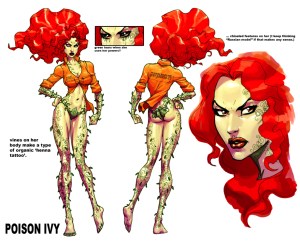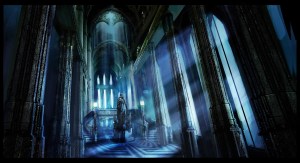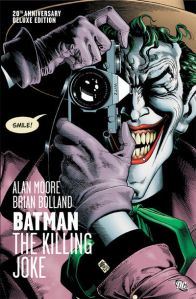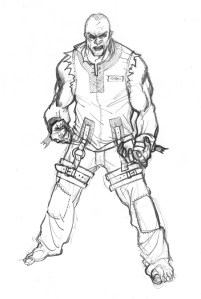The post-mortem on the Dark Knight’s hit game continues, as members from the Rocksteady development studio and writer Paul Dini talk about crafting Batman: Arkham Asylum. Read on to find out how they approached storytelling, dealt with fan expectations and writing for the Joker.
Now, Paul, I’m making an assumption but you’re not much of a gamer, right?
Paul Dini, writer for DC Comics and Warner Bros. Animation: Not anymore. About 14 years ago, I spent way too much time on the systems that were current then. Working from home meant spending all day playing games. I finally had to pull the plug.

What was your poison?
PD: They were all so primitive, then, but I played anything that was related to a show I was working on at the time. I’m kind of ashamed to admit it but it’d be things like Looney Tunes, Tiny Toons, the early side-scrolling Batman games on the Genesis. I got to the point where I was buying too many of them and I said enough. Then, a few years ago, I went to a friend’s house some years later and their kid was playing Goldeneye. I just sat there for hours soaking up all that James Bond. I fall back into the habit when I go over to friends’ houses. One Thanksgiving weekend, I had a lost weekend at a friend’s place with Grand Theft Auto.
What’s interesting about what you said is that you mention your old-school gaming being related to stuff you were working on. I’m sure you know the rap on licensed games is pretty bad.
PD: Oh, yeah. I do know that.
Arkham Asylum didn’t get as much hype as some of last year’s other big games. Was that because you didn’t want to set expectations too high or because of the bad preconceptions people tend to have about superhero games?
Sefton Hill, game director at Rocksteady Games: We knew that gamers tend to be down on video game adaptations of superheroes. But the team viewed it as a chance to upend those expectations. There was lots of positive comment once people got their hands on the demo. Getting to experience it first-hand helped change a lot of people’s minds.
One thing that the demo didn’t really convey is how lonely, sad and scary the experience of Arkham is. How did you approach the environment for such a well-known place in the Batman universe?

SH: We tried to treat the game as one big, holistic experience. The whole game map was laid out in a room and we’d keep track of what comes before and after each part to get that balance of experiences in the game. To go from stealth to combat to a horror-style Scarecrow Moment, those shifts in tone and focus keep the whole thing entertaining throughout. Getting the pacing and changes right not only makes it entertaining, but also gives it a depth too. There are particular times and places when players are more receptive. Some games try and hit you with a lot of story during action sequences but it’s very hard to pick up information when you’re running around and fighting for your life. But, if you’ve just survived a sequence, you tend to be more receptive to what your life means to you, or a bit of story. You could have the same story told, but if it’s at the wrong time, players just ignore it. Not because they’re not interested but because their focus is elsewhere. It’s really important to get that balance right.
PD: That’s one thing I learned from working on this game. A fight for your life against half a dozen ‘roided-out freaks isn’t the best place to cue up a soliloquy by the Joker.

Speaking of the Clown Prince of Crime, there’s a point where Barbara Gordon (as Oracle) references her history with him and the events of The Killing Joke. What was the thinking behind that?
Paul Crocker, lead narrative designer at Rocksteady: That’s our sort of reward for people not skipping stuff. Also, we know that there are a lot of Batman fans out there. Whether they’re die-hard fans of the comics or people who only know the character through the cartoons, we tried to put stuff in there for everyone. Killing Joke is one of my favorite stories and that’s kind of the archetypal Joker, so, in our approach, we worked elements of that into the take from the animated series.
Paul, Mark Hamill does the Joker’s voice and you’ve worked with him a long time now, ever since you were the lead writer on the Batman animated series in the ‘90s. Not only is this is arguably his best performance as the Joker, it might just top anyone else’s. And it’s not happening in a movie or TV show. It’s happening in a video game. How did it make you feel?
PD: The answer to that is that it’s all in the laugh. There’s comedy, tragedy, menace. He finds everything we throw at him when we write the Joker, including the tiny little shreds of humanity that are left. I wrote a bit in the Joker’s interview tapes–where he talks about how Batman’s not a hero because he wears a mask and Joker wears his real face–just because I wanted to hear Mark say it. It’s kind of how a crazy person sees himself in relation to the world and I wanted to see what Mark would do with that. The Joker is a tremendous vehicle for talented actors. Cesar Romero’s was a bubbly, lunatic criminal. Nicholson did him as a vain, preening manipulator. Heath’s performance of the Joker was remarkable, too. His was a low-simmering crazy street clown. Joker can be played all these ways and they’re all true. It’s why I think he’s the best villain ever.

You know, with his propensity for blowing stuff up, Ol’ Greenhair would’ve been at home in Rocksteady’s first game, Urban Chaos: Riot Response. That said, Arkham Asylum represents a radical change in tone from that game. You’re putting the player in a totally different milieu in each game. How was it navigating that shift?
SH: We were conscious of that shift and, thankfully, the one good thing about Batman is that there is a very specific tone that we wanted to get across. It’s easier to make violent games, give a character a gun and let him run around and shoot people. I think when you take away some of those design crutches, you can come with interesting new ways to solve problems of creating action. After all, the things that Batman can’t do define him as much as the things he can. The factthat he’s not just running through corridors and shooting everyone sets the game apart. It’s a bit more cerebral and we can’t rely on a lot of genre conventions simply because of who the character is. That’s a really positive thing for the game overall.
Do you feel like those genre conventions are things that choke the fun out of certain games or even the industry as a whole?
SH: I think that they wind up making some games feel more generic than they need to be. Other developers may feel like they need to sit with those conventions to be successful. I don’t think that’s the case. Don’t get me wrong. Some conventions are there for very good reasons. But at the same time, being forced to challenge those conventions sometimes creates more interesting answers. That was definitely the case with Batman.

